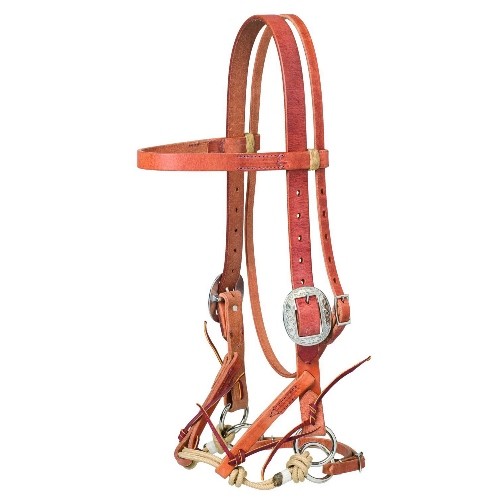
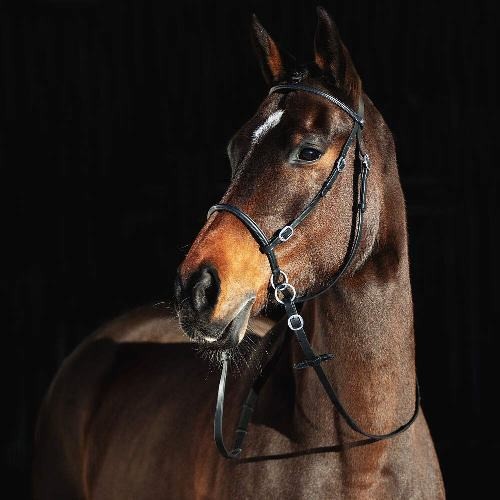
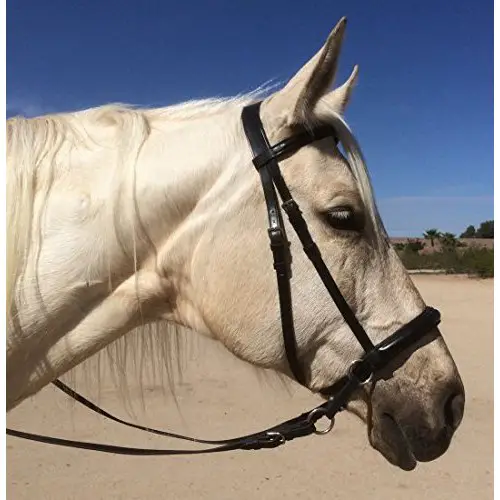
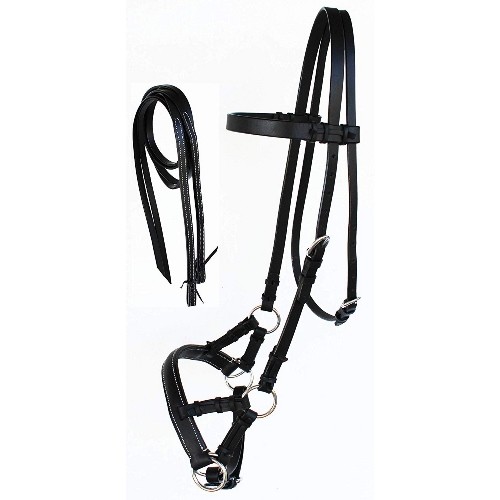

itless bridles are more popular than other harness types for ponies and horses. They are available in many styles and provide additional comfort for an animal when you do horse riding.
Why are bitless bridles better than bits?
Just like bridles with bits, the bitless models provide different levels of comfort for the animal. So the rider has to choose carefully and understand how the different designs function.
But, unlike the bit-based models, all bitless bridles apply pressure through the harness points/knots on the horse’s head. Typically, these points are located on the nose, cheeks and under the horse’s jaw. The point on the nose’s top is more preferable because it affects the horse during the training and at the same time provides maximum care, without hurting the animal.
Usually, a noseband has to be adjusted above the area where the hard bone begins and the soft tissue ends. This is the same line where the premolars start – about 3-4 fingers below the animal’s cheekbones. If you are not sure how to adjust the bitless bridles, please consult an expert.
Benefits of bitless bridles:
- Gentler control – no metal parts are placed in the horse’s mouth;
- Better “brakes” if the horse denies control because of being scared or tired;
- Non-painful pressure on the pole, nose and cheeks;
- The horse breathes easier and preserves more energy for riding;
- The animal’s neck is free;
- The better concentration of the animal;
- Reduced risk of breakdowns;
If you are searching for the best bitless bridles, check the following review that compares a few popular harnesses and includes the buyer’s guide.
Weaver Justin Dunn Bitless Bridle – the best for animal’s comfort!
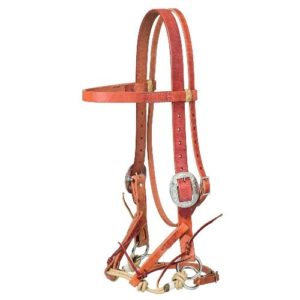 Justin Dunn offers the premium bitless bridle with a gentle but effective design for both a rider and horse. Instead of force, an animal responds to pressure through two strategically placed points (knots) located on the nose rope.
Justin Dunn offers the premium bitless bridle with a gentle but effective design for both a rider and horse. Instead of force, an animal responds to pressure through two strategically placed points (knots) located on the nose rope.
Besides the efficient and comfortable design, this harness is equipped with anti-rust buckles made of stainless steel.
| Pros | Cons |
| Handcrafted and weather-resistant harness | Doesn’t have reins |
| High-quality leather | The nosepiece can’t be replaced |
| Lightweight | Buckles are close to the horse’s eyes – be careful when adjusting this harness |
| Effective and comfortable design | – |
| Great for different riding styles | – |
| The buckles are made of anti-rust and stainless steel | – |
| Capable to withstand rugged use | – |
| Durable hardware | – |
| Easy to adjust | – |
This slim bridle is recommended for dressage, crossover and English-style riders. You may choose between the standard size for an adult horse and the draft adjustable size for ponies. Also, it is available in different colors – black, russet, canyon rose.
Horze Leather Bridle – the best for the reins!
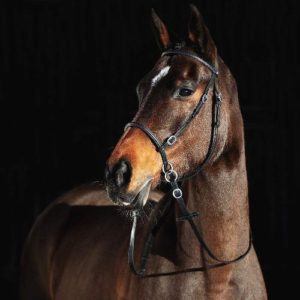 The Horze leather bridle is a bitless model made of premium 100% natural leather. Its halter-fit design was specifically made for training the horses who do not accept the bit. The pressure points are located on the chin, nose and poll.
The Horze leather bridle is a bitless model made of premium 100% natural leather. Its halter-fit design was specifically made for training the horses who do not accept the bit. The pressure points are located on the chin, nose and poll.
| Pros | Cons |
| The smart design with 3 pressure points | The noseband of the harness is not adjustable |
| Halter-style fit | The size is rather small and won’t fit some animals |
| Stylish buckles of silver color | The noseband is thin |
| 100% supple leather | – |
| Easy to put on the horse | – |
| Good for the use in cold weather | – |
| Good for the horses who have problems with teeth | – |
This black bridle is made of supple leather with adjustable web reins. The cheek pieces are attached to the major noseband through special rings – they won’t shift or roll.
Wonder Care Crossover– the best for quality!
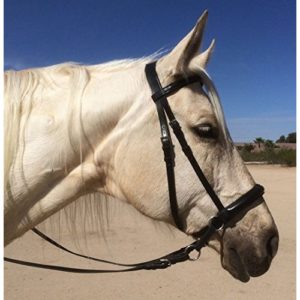 The Wonder Care Crossover bridle is made of 100% leather. The vegetable-tanned material (chrome-free) is both soft and durable. The premium leather is complemented by stainless steel hardware. Exceptional quality may be a good reason to invest in the purchase of this bridle.
The Wonder Care Crossover bridle is made of 100% leather. The vegetable-tanned material (chrome-free) is both soft and durable. The premium leather is complemented by stainless steel hardware. Exceptional quality may be a good reason to invest in the purchase of this bridle.
Also, the noseband includes soft padding for additional comfort. This harness won’t rub under the chin or above the nose.
| Pros | Cons |
| Premium quality leather and hardware | The cob size won’t work for smaller horses – basically, it is a large size |
| Handcrafted | – |
| Simple but subtle design | – |
| The noseband is adjustable (not removable) | – |
| Gives the horse freedom to graze | – |
| Easy to adjust | – |
Thanks to the simple design of 2 loops – one over the nose and the other for the poll, this bridle can safely and gently embrace the horse’s head. This bridle is good for different riding styles. In addition to the adjustable noseband, it includes 3.4-inch wide leather reins.
Tory Harness Side Pull – the best for the safe horse training!
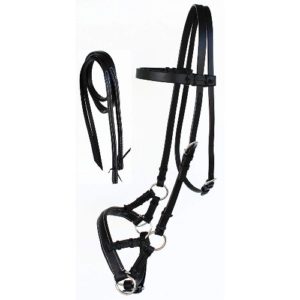 Tory Leather released the side-pull harness with 7-inch reins and 5.8-inch buckles. It weighs only 2 pounds and has the average size. One of the best features is a double, stitched noseband. In addition, this bridle has another center buckle for extra safety.
Tory Leather released the side-pull harness with 7-inch reins and 5.8-inch buckles. It weighs only 2 pounds and has the average size. One of the best features is a double, stitched noseband. In addition, this bridle has another center buckle for extra safety.
| Pros | Cons |
| Dipped harness leather | Havana color only |
| Adjustable | Average size only |
| Anti-rust stainless steel hardware | – |
| Buckle end reins are good for quick on and off | – |
This side-pull bridle can serve as a great training device. You may use this adjustable harness to control the horse of any age, especially if the animal is not used to back riding.
Horse Western Bitless Bridle – the best size!
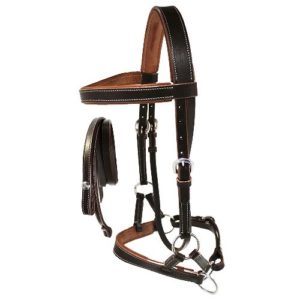 This side-pull bridle is comfortable for average and large horses. You would be able to control the horse gently and effortlessly. The lightweight bridle is supplied with 7-inch and 5.8-inch tie-end reins.
This side-pull bridle is comfortable for average and large horses. You would be able to control the horse gently and effortlessly. The lightweight bridle is supplied with 7-inch and 5.8-inch tie-end reins.
| Pros | Cons |
| Lightweight | The plastic liner could be better |
| Fits any size from average to large | – |
| Full side-pull harness with tie-end buckles | – |
| Handcrafted | – |
| Double-stitched | – |
| Oiled for additional durability | – |
| Anti-rust stainless steel hardware | – |
| Padded noseband, crown and browband | – |
The manufacturer designed this harness for the animals who have problems with teeth or the history of injuries. It fits almost any head size just right and also looks good.
The Buyer’s Guide
Firstly, I’ve learned that a headgear without a bit and with reins attached to a noseband used for controlling a horse is called a hackamore (also known as bitless bridles). So, below you will find the results of my tests and a few tips for people who need to choose leather bitless bridles or raw animal skin for making such headgear for a horse.
Type
There are a few major types of bitless bridles:
- The rope halter and natural hackamore – only for the nose pressure;
- The fully mechanical hackamore – only for the nose and jaw leverage;
- The crossover harness – the pressure on the cheeks, nose and poll;
- The side-pull bridle – only for the pressure on the side of the nose and top;
To figure out what type of a bitless bridle will fit your horse, you should take into account such factors as the horse’s sensitivity and past history.
Is your horse more sensitive to the quick pressure or is he or she stoic or immune to the pressure at certain points?
Sensitive animals usually prefer being trained with a looser fitting bridle (think of the lightweight, rope halter). Such bridles offer extremely light pressure. Consider avoiding tighter crossover or leverage-style bridles. Also, sensitive horses will respond better to gently side-pull harnesses.
More stoic horses are usually less responsive to pressure. They may ignore the soft pressure provided by a soft flat noseband. In this case, you may want to try a rope halter or crossover style. The side-pull bridles can also help. Mechanical hackamores are probably not the greatest choice because they won’t provide a stronger directional rein.
Size
Typically, U.S. and European leather bitless bridles come in 5 sizes:
- Extra full or large (mostly for Warmbloods);
- Full or medium;
- Draft (for draft horses);
- Cob or small (mostly for Arabians);
- Pony;
Also, the rider should consider the width of the accompanying reins. The standard size is 5/8”.
Color
Most manufacturers use natural top-grain leather for making the bitless bridles. That is why the color typically imitates natural leather shades – Havana brown, hazelnut, black, brown. There are light-colored harnesses as well – they will look good on smaller horses and ponies. To make the harness a bit darker, run it with special leather oil.
Level of training
Most experts claim that well-educated and trained horses can accept any bridle. Because they got used to the pressure coming from the seat and leg aids more than the reins. But a young or non-trained horse will respond better to any side-pull leather bridle. They may experience difficulties with crossover bridles and mechanical hackamores. At least, until they will get used to the directional pressure.
Things to consider when selecting leather bitless bridles
First things first – if your budget is low, pay attention to the quality of the used leather. This factor will determine how long the bridle will last. At the same time, of course, do not forget that the key to durability will continue to care for a hackamore when using it!
When choosing a leather bridle, consider the size and shape of your horse’s head. Wide capsules are popular now, but if they don’t fit well on your horse, then you shouldn’t buy such a headgear.
Bridles with wider reins will look good on a big head with a strong backbone. Sometimes they come with wide substrates that make them visually wider. If the horse’s head is tiny, a bridle should not be “heavy” either – pay attention to models with narrower reins.
If you rarely buy a leather bridle, it can be difficult to see the difference between $50 and $500 hackamore. To determine whether a bridle is made of high-quality leather or not, whether it will serve you for a long time or whether it will be enough only for one season, pay attention to the following things:
- The quality of stitching. Check if the stitching lines are even. Are the stitching points stitched or riveted? The latter method is cheaper and loses in terms of reliability. Is the stitch tight? Does the thread look thick and strong? Opt for string stitches all over a hackamore;
- Look at the headband and capsules. Expensive bridle reins have leather inserts to give the capsule and headband a rounded shape. The cheaper ones have plastic reins. Plastic inserts are not so flexible and can break;
- Clasps. Evaluate how strong the clasps are, the moving parts should move well. Have the holes been punched correctly? They must be;
- Evaluate the rein edges. The front side of reins will be smooth, should have no scratches, the seamy side will be smooth too, but more grainy;
What leather to buy for DIY bitless bridles?
High-quality leather is very durable and has no defects. Sometimes the tanning and finishing process is more important than the quality of the raw material. The best for leather bitless bridles is vegetable tanning. During this process, color permeates the entire structure of the material. If you bend the rein, the sliced leather will not change color. A bridle, which was dyed via the usual method, will not pass such a test. If a cheap dye was used, the leather bridle will pour out into the rain and leave traces on the horse’s hair, soaking it with sweat.
My choice of 5 best bitless bridles:
- Dunn hackamores will fit a small horse or large pony. It boasts a premium rope nose. It is very lightweight;
- Leather Bitless Bridle offers silver-colored buckles, made of soft material. There is a great halter-style fit;
- Leather Crossover is a premium product, with stainless steel hardware and soft padded nose;
- SIDEPULL REINS is another nice product in my list, with a double-layered noseband;
- Combo REINS 7710 has a nice colored padded browband that is quite wide;
Video Guide: Making a Bitless Bridle
Final thoughts
The horse’s comfort should come first. Look for the adjustable bitless bridles that will do for the gentle training. The horse should move the jaw to yawn, chew and breathe without any discomfort. The more lightweight bridle, the better.
Most manufacturers offer the money-back guarantee because they understand that their product can be too large or too tight for the horse. Consider testing a few bitless bridles before using one harness.






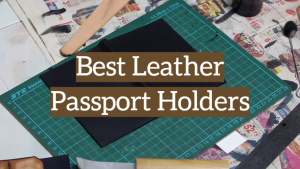
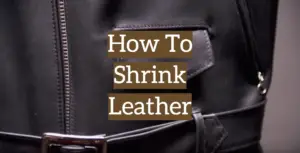
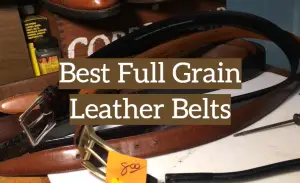
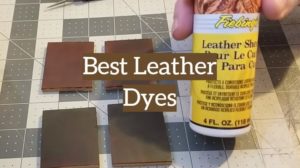






I used to own two horse and so I have some experience in making and adjusting homemade bitless bridles. The video you included here is a good overview for people interested in the process or who are hoping to try it for themselves. Just do not cheap out on the quality of your leather or the stainless steel hardware you incorporate into it.
If you are an active person who loves to ride horses. I have multiple horses and race occasionally. If you are serious about getting a bridle I would recommend checking out the Leather Crossover. It stays in place and will last quite a long time.
Hello, Fred! Thanks for your comment.
I feel like riders and trainers should always try their horse in a bit and a bitless bridle, see which works out best for them instead of just deciding for them. By ‘deciding for them’ I mean the trainers just sticking to one and never trying the other (e.g. just sticking to a bit and never trying bitless instead of giving both a bit and bitless a try).
Hello, Matthew! Thanks for the comment.